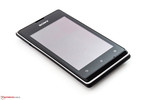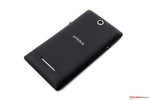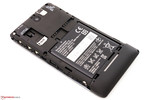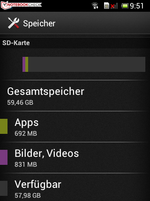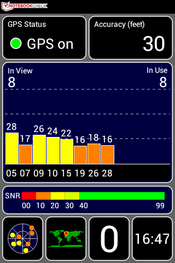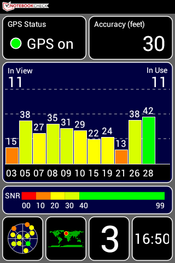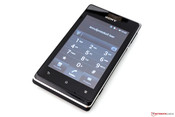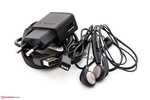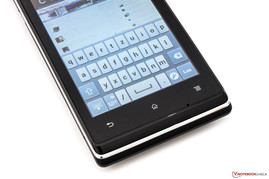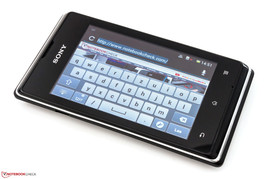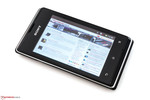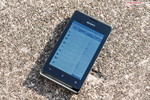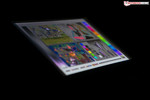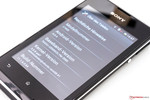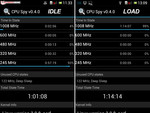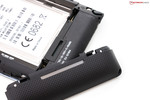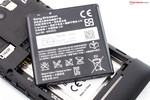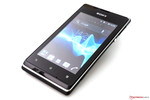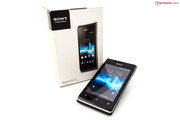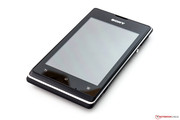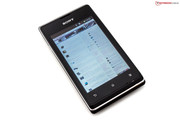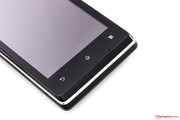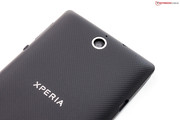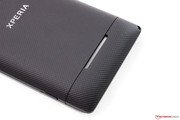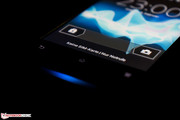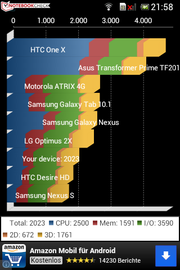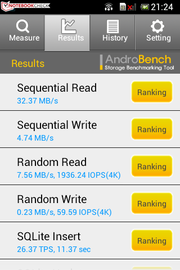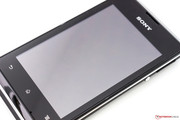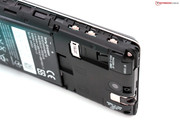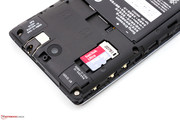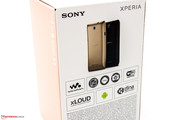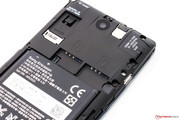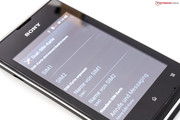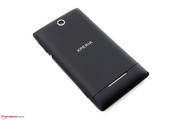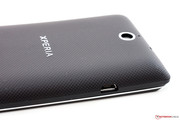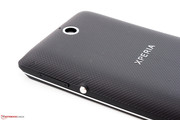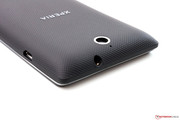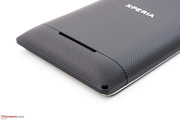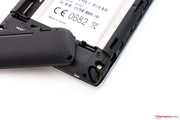Review Sony Xperia E Dual Smartphone

For the original German review, see here.
The principle behind dual-SIM smartphones is pretty simple. It is possible to switch between the different cards while the phone is running so you carry less and work more efficiently. Evidently, such a device is also useful for private use for people with two mobile phone numbers, since the switch of the SIM takes time and effort. Another advantage is the automatic separation of the data. In our opinion other important factors for such a device are also an exchangeable battery and a card reader and the possibility to easily switch between the cards.
The Sony Xperia E dual is a newer version of the Sony Xperia E. The latter is available for 10 Euros (~$13) less. Inside the smartphone there is a Qualcomm Snapdragon S1 Single-Core-SoC running at 1 GHz. Furthermore, the smartphone is also equipped with an integrated Adreno 200 graphic unit, 512 MB RAM, 4 GB internal storage space, 802.11b/g/n WLAN and a 3.2 megapixel camera for snapshots. It is powered by a relatively older version of Google Android, namely 4.0.4 (Ice Cream Sandwich) where an update is planned already.
In this review we are testing the smartphone from tip to toe. An important dual-SIM competitor is the Samsung Galaxy S DUOS with a 4-inch screen. Moreover, there are standard mid-range devices available. The Xperia J is the new line in the portfolio of Sony. Is the Sony Xperia E dual a reasonable expansion of the portfolio or is it just another first-time user segment product?
The design of the Sony Xperia E dual is very reminiscent of the other devices of the series. Its black case of polycarbonate convinces through a mixture of matte and glossy surfaces. A thin frame in chrome helps smooth the design. A cool feature is the blue flashing LED stripe at the bottom of the device; however it only becomes visible in dark environments. The manufacturing of the individual parts of the case is of high quality. The smartphone sits nicely in the hand through the rounded backside. The textured surface results in a comfortable feel. The finish is too smooth in our view. A thin coating would offer much more hold.
Unfortunately, the stability is not totally convincing for us. Even when applying small force, one can already feel a certain deformation of the case. This is due to the multi-part case. A single body case usually performs much better. Another point of concern is the PMMA display protection (Polymethylmethacrylate). In comparison to Gorilla glass, it is not very robust. When applying stronger pressure, one can see waves on the TFT display.
The phone measures 61.8 x 113.5 x 11 millimeters (~2.4 x 4.5 x 0.4 inches/W x L x H) and weighs 116 grams (~0.35 pounds). Although it is relatively light, current smartphones are a bit thinner usually. It is comparable to the Samsung Galaxy S DUOS GT-S7562 in terms of size and weight.
The ports on the phone come as no surprise. A headset or external speakers can be connected via the 3.5 mm stereo port on top of the phone. Fresh energy as well as data from a PC can be received through the micro-USB (left side). In addition, there is also a card reader so that the integrated 4 GB flash memory can be expanded (Net capacity: 2.28 GB). Even though the specs in the manufacturers’ data give a maximum of 32 GB, micro-SD cards of up to 64 GB are supported.
The control of the device is performed through buttons all around it. On the right hand side there is a compact volume switch and the power button which is not so convincing in its shape. Moreover, the individual pressure points are too imprecise. Right below the screen there are located the three typical Android touch buttons. We are not going to explain their functions in more detail. They are illuminated so that these controls are easily visible in the evening.
Software
The Sony Xperia E dual ships with Google Android 4.0.4, alias Ice Cream Sandwich. The launcher was slightly modified visually. An update to the current version of Google Android (4.1) is planned according to Sony. The normal version of our test device (single-SIM card) already features Jelly Bean. A negative point is the preinstalled bloatware that is abundant. The performance of the system is fine. Some longer loading times and the occasional micro lag are a consequence of the relatively weak hardware specs.
Communication & GPS
In terms of wireless technology the smartphone offers simple standard equipment. Local wireless (WLAN) can be received using the following standards: 802.11b/g/n. For data transmission between the device and peripheral devices there is Bluetooth 2.1 +EDR included. The current version Bluetooth 4.0 is much faster and also saves a lot of energy in comparison to its predecessor, but in the lower price segment this technology is rarely included.
Obviously, one also has mobile access to the Internet with the Xperia E dual. The two slots are shaped for mini-SIM cards. The smaller micro or nano SIM cards can be used via adapters. The wireless module supports WCDMA/UMTS (HSPA) through the following frequencies: 850, 900, 1900 and 2100 MHz.
With A-GPS it is possible to use location dependent applications and services on the device too. A good example is navigation in the car. We checked the performance of the chip with the app GPS Test. Indoors the performance is mostly fine, although outside positioning is still much faster. However, when going into a staircase, the cellar or an underground parking lot, then this feature of the Xperia reaches its limit.
Telephony
The apps of the device are tidy and clearly arranged. Contacts can easily be imported from the SIM cards or from ones Google account. Through a separation into groups, it is easy to keep the private and the business contacts apart. The switch between the SIM cards takes place through an elegant widget that can be placed on a home screen. There are further settings available in the properties of the system. The Sony Xperia E dual supports the four main GSM frequencies (850, 900, 1800 & 1900 MHz) so that it can be used in most countries.
Camera
On the backside there is a camera module that offers a resolution of 3.2 megapixels (2048x1536 pixels). Hence, it provides a solution mostly for snapshots that do not require high demands. An LED light or flash is not integrated while this extra is included in the Sony Xperia J. For comparison we have analyzed the high-end Apple iPhone 5 device versus Sony`s system camera. Photos in the daylight without digital zoom are fine. On the edges of a building and on the outside there are some flaws though. The zoom is not of much use, since it lowers the quality significantly.
In addition to photos, the Xperia E dual can also make video recordings. However, with a maximum resolution of 640x480 pixels (VGA) they do not satisfy today’s HD standards. A cheap digital camera may be the better solution for simple, but beautiful recordings.
Accessories
The package contains the most important accessories for basic use. Due to the low entry price there are no extras provided. Besides the main device, Sony includes a lithium-ion battery, a UBS cable, the modular USB charger, a simple headset, and a printed instructions manual. Sony offers many products in its Store where it is often worthwhile to make a price comparison. Interestingly the company does not sell any second batteries or replacement batteries through the website.
Warranty
Sony offers a warranty of 24 months for the Xperia E dual, which starts from the date of purchase. The battery and the accessories included are protected for 12 months through the warranty.
Input Devices and Controls
Input commands are made through a capacitive 3.5-inch touchscreen which converts touch with very high precision. The device also supports multi-touch gestures, but to a limited extent, since the panel can only cope with two fingers at the same time. However, in everyday life this fact is not noticed. A virtual keyboard is used for inputting text. The visual style of the keyboard has changed slightly. Overall, the layout seems very comfortable. Only the keyboard uses a lot of space in landscape format, as we have already discussed in the test of the Sony Xperia J.
The Sony Xperia E dual features a glossy 3.5-inch screen with a resolution of 320x480 pixels in the 2:3 format. This results in a relatively low pixel density of only 165 PPI so that the picture looks very grainy. The difference becomes especially apparent when compared to the Apple iPhone 5, Google Nexus 4 or the Samsung Galaxy S3. Another negative point is the display technology that is being used in the device. It is an LCD-TFT display whereas high quality devices offer IPS or AMOLED displays.
We have measured the quality of the screen with the Mavo screen from Gossen. The panel reached a light density of 315 cd/m². This value is pretty good in class comparison, even though it is not the brightest of all. The Samsung Galaxy S DUOS as a direct competitor is a bit brighter on average. With 91% the illumination level is very uniform and also convincing. Overall, these are good results for this section of the test.
| |||||||||||||||||||||||||
Brightness Distribution: 91 %
Center on Battery: 309 cd/m²
Contrast: 719:1 (Black: 0.43 cd/m²)
The black level is low with just 0.43 cd/m² so that an almost deep black can be presented. Still a light gray hue is noticeable and because of the technology in use that cannot be avoided either. The given brightness and the black level yield a contrast ration of 719:1. The measured values are in mid-range and these good results also beat the competitor from Samsung.
Figuratively speaking the device comes as a double-edged sword for outdoor use. At maximum brightness of the screen the content is clearly visible, however only when in direct view of the screen. Viewed from the side, content is not recognizable anymore. If the brightness is decreased, then the reflections due to the glossy surface increase in turn. Hence, an efficient use is not possible anymore. In order to solve this one can change the sitting position or purchase a matte display protection foil.
The viewing angle stability is probably the biggest problem of the LCD-TFT display in use here. Even just a small deviation along the vertical axis leads to an inversion or a fade-in of the content. The screen deals better with horizontal movements. The aforementioned alternative technologies usually offered at a higher cost do not have problems with this. The cheaper choice comes with this trade-off.
Inside the Sony Xperia E dual there is a Qualcomm Snapdragon S1 MSM7227A System-on-a-Chip (SoC) at work. We have already analyzed the chip in detail in the tests of the Samsung Galaxy S DUOS and the Sony Xperia J. In this case it is a single-core chip (Cortex A5) based on the ARMv7-Architecture running at 1 GHz. The SoC is produced in 45 Nanometer size and contains the Adreno 200 (Enhanced) graphic unit.
It also contains 512 MB RAM. Modern devices in the mid- and upper range usually offer dual or quad cores and a maximum of 2GB RAM. Naturally, one should not compare apples and oranges here, since the costs of such devices are much higher too.
First, we checked the time behavior of the SoCs with the tool CPU Spy. In idle mode the snapdragon S1 is working over 90 percent of the time with only 245 MHz, hence consuming little energy. Under load the maximum performance of 1008 MHz is activated without any problems.
Then we enter the benchmark test round with the synthetic tests. Interestingly, our test device is faster than the Sony Xperia J, even though they both feature the same hardware. This becomes clearly visible in the GPU benchmark test NenaMark 2. Our device with the Adreno 200 GPU reaches 27.4 FPS (frames per second) there. The Xperia J with only 19.6 FPS performs about 28% worse. The Samsung Galaxy S DUOS is about on the same level as the Sony Xperia J. For multi-thread calculations from Linpack there is only a difference of a few points in the scores of these three devices. In addition, we have also included the Google Nexus 4 in the comparison table so that the difference to a faster Android smartphone can also be seen.
| AnTuTu v3 - Total Score (sort by value) | |
| Sony Xperia E dual | |
| Sony Xperia J | |
| Google Nexus 4 | |
| NenaMark2 - --- (sort by value) | |
| Sony Xperia E dual | |
| Sony Xperia J | |
| Samsung Galaxy S DUOS GT-S7562 | |
| Google Nexus 4 | |
| Geekbench 2 - 32 Bit - Total Score (sort by value) | |
| Sony Xperia E dual | |
| Sony Xperia J | |
| Samsung Galaxy S DUOS GT-S7562 | |
| Google Nexus 4 | |
| Basemark ES 2.0 - Taiji Free (sort by value) | |
| Sony Xperia E dual | |
| Sony Xperia J | |
| Samsung Galaxy S DUOS GT-S7562 | |
| Google Nexus 4 | |
| Linpack Android / IOS - Multi Thread (sort by value) | |
| Sony Xperia E dual | |
| Sony Xperia J | |
| Samsung Galaxy S DUOS GT-S7562 | |
| Google Nexus 4 | |
In the browser benchmarks it yields some good and some bad results. On the one hand, the Xperia E dual reaches a good score of 325 in the Peacekeeper-Benchmark. On the other hand, in Browsermark 2.0 the device turns out to be too slow. Comparable devices are at least 50 percent better here. In Google V8 the result is average, hereby the Google Nexus 4 with the Chrome browser unsurprisingly scores the highest. Last but not least, we listed the Sunspider-Benchmark. Here, a lower score is better. This Sony device does not deliver good results in this benchmark though. The HTC Windows Phone 8S convinces us with just 1410 milliseconds. A recommendation: also try using Google Chrome from the Play Store.
| Peacekeeper - --- (sort by value) | |
| Sony Xperia E dual | |
| Sony Xperia J | |
| Google Nexus 4 | |
| HTC Windows Phone 8S | |
| Google V8 Ver. 7 - Google V8 Ver. 7 Score (sort by value) | |
| Sony Xperia E dual | |
| Sony Xperia J | |
| Samsung Galaxy S DUOS GT-S7562 | |
| Google Nexus 4 | |
| HTC Windows Phone 8S | |
| Browsermark - --- (sort by value) | |
| Sony Xperia E dual | |
| Sony Xperia J | |
| Google Nexus 4 | |
| HTC Windows Phone 8S | |
| Sunspider - 0.9.1 Total Score (sort by value) | |
| Sony Xperia E dual | |
| Sony Xperia J | |
| Google Nexus 4 | |
| HTC Windows Phone 8S | |
* ... smaller is better
In conclusion, the AndroBench tests the performance of the integrated flash memory. Overall, the Sony Xperia E dual delivers a good presentation in the range of the Samsung Galaxy S DUOS. In comparison, the readout performance of the Xperia E duo is really good. The Google Nexus 4 is much better in this aspect too.
| AndroBench 3-5 | |
| Random Write 4KB (sort by value) | |
| Sony Xperia E dual | |
| Sony Xperia J | |
| Samsung Galaxy S DUOS GT-S7562 | |
| Google Nexus 4 | |
| Random Read 4KB (sort by value) | |
| Sony Xperia E dual | |
| Sony Xperia J | |
| Samsung Galaxy S DUOS GT-S7562 | |
| Google Nexus 4 | |
| Sequential Write 256KB (sort by value) | |
| Sony Xperia E dual | |
| Sony Xperia J | |
| Samsung Galaxy S DUOS GT-S7562 | |
| Google Nexus 4 | |
| Sequential Read 256KB (sort by value) | |
| Sony Xperia E dual | |
| Sony Xperia J | |
| Samsung Galaxy S DUOS GT-S7562 | |
| Google Nexus 4 | |
Games
The Sony Xperia E dual is not a gaming monster with its somewhat lower hardware specs, but it plays most game titles just fine. Current 2D-games and many 3D-titles run without any major problems. For instance, Temple Run 2 runs smoothly throughout, although the graphics are sometimes not very beautiful because of the low display resolution. The gyroscope converts any movement very rapidly. Demanding titles, such as GTA III, can bring the hardware to its knees. Lagging can significantly impact the fun of play. Also, the loading times before and during a game can be nerve-wracking. It was not possible to start the game ShadowGun: DeadZone in this test.
Voice Quality
The voice quality of the Xperia E dual leaves a good impression. The caller is understood clearly and the same holds for the receiver on the other side. One point of criticism is the suppression of background noise. The headset that is included is fairly cheap, but satisfactory. People who make a lot of calls would probably change to a higher quality headset which sits better in the ear over time and also offers better sound quality.
Temperature
Rejected heat is led away passively through the case. Overall, the smartphone leaves a good impression. It stays cool during load. The higher temperature on the left hand side of the device is noticeable. Presumably the SoC and other system components are located under there. All values remain in the safe range though with a maximum temperature of 36.2 °C (97.16 °F), whereas the HTC Windows Phone 8S or the Samsungs Galaxy S DUOS climb up to over 40 °C (104 °F) under heavy load. This is a plus for the Sony Xperia E duo.
(+) The maximum temperature on the upper side is 36.2 °C / 97 F, compared to the average of 35 °C / 95 F, ranging from 21.9 to 56 °C for the class Smartphone.
(+) The bottom heats up to a maximum of 32 °C / 90 F, compared to the average of 33.8 °C / 93 F
(+) In idle usage, the average temperature for the upper side is 29.6 °C / 85 F, compared to the device average of 32.7 °C / 91 F.
Speakers
To play audio material there is a mono speaker at the lower backside of the device. The sound impression is not very convincing. Trebles are too pronounced. Bass and low-pitched sounds are missing entirely. The maximum volume is convincing, but the sound produces distortions from 60 percent onwards. External and peripheral audio devices can be connected through the 3.5 mm stereo port and the quality of transmission is excellent.
Energy Consumption
The power consumption of the components constitutes a crucial point for a device with limited battery capacity. Sony includes a battery with 1500 mAh which equates to 5.6 Watt-hours.
In office use the consumption of the smartphone is between 0.7 and 1.4 Watts. The Sony Xperia J consumes less electricity in this scenario, although it has identical hardware, but a bigger screen. The Galaxy S DUOS from Samsung is not as good with 1.8 Watts at the top end of the consumption table. Hence, in comparison to the Xperia J this test device does not convince us in this scenario. During heavy load the consumption of both Sony devices is identical with 1.6 or 2.1 Watts, respectively. The Galaxy S DUOS again consumes more electricity with a maximum of 2.7 Watts, while this smartphone is equipped with a bigger 4-inch display.
| Off / Standby | |
| Idle | |
| Load |
|
Battery Runtime
In addition to the calling time of 6 hours and 12 minutes as specified by Sony, we have undertaken our own running time measurements. The beginning is marked by the maximum battery run time under minimal screen brightness and all wireless connections disabled (airplane mode). After 18 hours and 43 minutes the Sony Xperia E dual has to be recharged. The Xperia J, with a bigger battery and lower consumption, lasts longer at 21 hours and 30 minutes. The Samsung Galaxy S DUOS comes nowhere near with only 12 hours and 36 minutes.
At the other extreme is the minimal run time under heavy load that we have simulated with the tool Stability Test. The brightness of the screen was maximized and all wireless connections also enabled. After 3 hours and 17 minutes a full battery charge is drained. In this scenario the Xperia J and the Galaxy S DUOS last longer.
A more common scenario is estimated with “surfing with WLAN” mode. With a standard brightness of 150 cd/m² every 40 seconds a new web page is displayed. The test device lasts almost 10 hours in this mode. The difference to the Xperia J is about three hours. The Samsung device lasts about 30 minutes less than the test device.
The Sony Xperia E dual is a good dual-SIM smartphone for little money. One should not expect too much besides this function though. The case is undoubtedly fancy, but the stability is not ideal. The card reader allowing up to 64 GB is a useful feature considering the small internal storage provided. The integration of the dual-SIM function proves to be good in Android. An update to Google Android 4.1 (Jelly Bean) is yet to be released by Sony though.
The 3.5-inch touchscreen offers convincing test results. However, the low resolution of 320x480 pixels and the use of LCD-TFT technology are not up to date anymore. The performance is fine for a device that costs less than 200 Euros (~$265) and performance in everyday life is good. For gamers and multimedia enthusiasts it is the wrong choice. The battery life based on the 1500 mAh battery is fine; however the consumption in office use is too high in comparison to similar products. Overall, it is a good device for first-users who do not want to carry around two smartphones all the time. Nonetheless, the question still remains why so far only smartphones in the lower price range offer the dual-SIM feature in Germany.


 Deutsch
Deutsch English
English Español
Español Français
Français Italiano
Italiano Nederlands
Nederlands Polski
Polski Português
Português Русский
Русский Türkçe
Türkçe Svenska
Svenska Chinese
Chinese Magyar
Magyar
